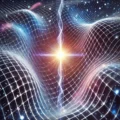The Foundational Insight
“Not all revolutions begin with a bang—some start with a differential.”
Abstract
A fundamental reassessment of gravity reveals a deeper causal relationship: gravity may not be a force acting at a distance, but rather a consequence of the variable speed of energy propagation through a structured vacuum lattice. This idea is expressed by the governing relationship:
![Rendered by QuickLaTeX.com \[ \setlength{\fboxrule}{1pt} % Default is 0.4pt \fbox{ \parbox{10em}{ \centering \Large $g_v = -\dfrac{dc}{dx}$ } } \]](https://gravityz0.com/wp-content/ql-cache/quicklatex.com-b286ee9b8e69dff4dee6880b891a5720_l3.png)
where gv is the gravitational vector potential, and dc/dx describes the local spatial gradient in the speed of energy propagation, c.
This approach reinterprets the vacuum not as emptiness, but as a field with structure and impedance—a compressible, variable medium capable of hosting oscillatory energy transmission. Here, energy doesn’t just move through space—it defines space. The gravity we measure emerges from local variations in the lattice’s ability to transmit energy.
Introduction
This relation, read plainly, suggests that gravitational acceleration is proportional to the rate of change of the speed of light with respect to time. On its surface, it may appear algebraic or dimensional. But beneath its quiet formality lies a recursive reimagining of physical law: gravity, light, and the lattice through which they propagate are no longer disconnected domains—but interdependent states in a unified energetic structure.
This equation is the ignition point for what has become a broader effort: to reassess and redefine the most fundamental physical concepts. Where General Relativity explains gravity as curvature of spacetime geometry, this formulation treats gravity as a gradient in the stiffness of the vacuum, expressed by the rate of change of light’s maximum speed—a dynamic property of the energetic field lattice (Ξ-lattice). From this view, c is not a fixed constant but a local field property—responsive to energy density and field interactions.
Why It Matters
- Gravitational Acceleration as an Optical Gradient: In this view, objects “fall” because the medium of transmission—what we call space—permits light to move slightly slower deeper into gravitational potential. That gradient in c produces what we perceive as acceleration. It’s not that mass bends space—it perturbs the field stiffness, slowing the propagation rate of energy.
- Time and Light: Coupled, Not Independent: Time is not treated as an external axis, but as an emergent parameter defined by the phase coherence and impedance in the lattice. Half the energy of any charge resonance may reside in an orthogonal, imaginary-time domain (–j), unseen but detectable by its synchronized reaction in +j time. This coupling adds a missing depth to phenomena like dark energy, entanglemenPhoton and Particle Genesist, and quantization.
- Photon and Particle Genesis: With this insight, photons become not discrete wave packets flying through space, but events—localized soliton emissions triggered by impedance mismatches at charge transitions. A true photon is not the wave but the spike that causes the wave to form. The classical notion of a particle dissolves into the framework of a resonant event bounded in impedance space, recurring through standing wave formation.
Historical Irony, Theoretical Fulfillment
The phrase “Gravity in a new light” was originally coined as a linguistic pun. It now resonates as a technical fulfillment: gravity is a function of light, and light is a function of lattice impedance. This recursive loop redefines causality, rooting dynamics not in geometry or absolutes but in the real-time response of a structured energetic medium.
While this idea defies the orthodoxy of General Relativity and upends the standard model’s assumptions about constants and vacuum, it offers something rare: coherence. It bridges paradoxes, links disparate domains, and provides experimental opportunities for falsification and refinement.
Explore Further
This page is the gateway. If this principle resonates with your thinking or challenges your assumptions, you’re invited to follow the recursion:
Final Word
This is not speculation born of discontent. It is structure born of observation and recursion. Like all revolutions in science, it began with a simple deviation from accepted norms. Gravity is not a curvature. It is a differential.
And this is where it begins . . .
